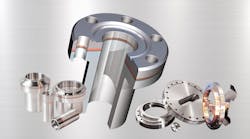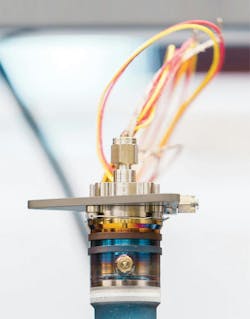Of the 118 elements in the periodic table, 92 are metals. These metals exhibit an incredible diversity of physical properties useful to engineers. However, even with this variety, there is often no single metal or alloy that perfectly satisfies all design requirements.
A particular metal may offer properties such as hardness or corrosion resistance that work well for one aspect of a design, while lacking some other important property such as thermal conductivity.
One way around this dilemma is to take advantage of the properties of two or more metals using dissimilar metal joining technologies.
Optimize Performance by Capitalizing on Material Traits
Even though a particular metal or alloy may be well suited for a task, there are trade-offs between conflicting properties, manufacturability and cost. For example, stainless steel is commonly used for evaporation stages in cryogenic equipment. It is generally corrosion-resistant, remains ductile at cryogenic temperatures and is easily weldable. And, because it has poor thermal conductivity, it prevents undesired transfer of external heat to the cold stage heads.
However, heat also needs to be efficiently removed at these heads, and stainless steel is poorly suited for this. It is also slow to machine, making it costly. A practical solution to this problem is to bond a different metal with better thermal conductivity to the stainless.
Commonly copper or aluminum are used for these heat elimination points. Both copper and aluminum have excellent thermal conductivity, remain ductile at cryogenic temperatures, and meet manufacturability and cost requirements. The combination of high thermal conductivity in one location and poor thermal conductivity in another enables efficient heat management. This allows cooling to cryogenic temperatures, while reducing the transfer of ambient heat to the target.
Dissimilar Metal Manufacturing Methods
It is challenging to join dissimilar metals so that bonds are mechanically robust, totally hermetic, and remain ductile in pyrolytic or cryogenic temperatures.
Simply welding dissimilar metals in most cases is not possible. Different metals often react with one another to form brittle intermetallic compounds which cause leaks to weaken the joint. Or the two metals may melt at different temperatures which prevents them forming weld pools and proper metallurgical bonds.
Solid-state metal bonding processes offer many advantages over conventional welding. In these processes, energy is applied to the surfaces of the metals being joined. No melting occurs. Explosion, diffusion and roll bonding are the main methods comprising solid state bonding.
Explosion bonding uses the impact velocity from explosives to generate a reactive plasma at the colliding surfaces. As the impact propagates across the colliding surfaces, the plasma strips oxides and presses the metals together with so much sudden force that the metals dynamically flow, forming a wave pattern. Explosion bonding occurs at ambient temperatures which preserves grain structure and temper, as well as the full mechanical and thermal properties of the parent metals. These bonds are strong and ductile.
Diffusion bonding is a process whereby the parent metals are bonded under compression at high temperature. It is a precise operation ideal for joining net shape or near-net shaped parts. Often used for joining similar metals, it can also be used to join dissimilar metals. Depending on the metallurgy, diffusion bonded joints can be heat treated to restore grain structure and temper that may have occurred in the process.
Roll bonding involves passing two or more metal sheets between a pair of rollers, applying modest heat and high pressure to cause the surfaces to bond together. The surfaces of the metals being joined are stretched by the rollers which breaks native oxides and presses the clean metallic surfaces together to form metallurgical bonds. It is not a net or near-net process but is well suited for bonding relatively thin and narrow strips of metal as limited by the size and power of the rolling press.
Through solid state bonding, a huge variety of metals can be joined. These hermetic, seamless units can then be further machined and welded to adjacent metals. The mechanical properties of the bonds are often equivalent to or better than the weakest of the parent metals.
So high are the bonds in quality and strength, they are used in Ultra High Vacuum (UHV) and Extreme High Vacuum (XHV) applications for the semiconductor, chemical processing, cryogenics, aerospace and particle physics industries where even infinitesimal porosity or leakage is intolerable.
Bimetal and Multi Metal Applications and Benefits
Contrasting Properties – Take advantage of multiple metal properties in a single machined component.
• Thermal conductivity: Highly conductive materials are bonded to poor thermal conductors to control heat transfer as mentioned above.
• Thermal discontinuity: In this case, a poor thermal conductor like Inconel or Hastelloy is sandwiched within another metal to limit the transmission of heat.
• Thermal expansion: Multimetals can be designed to change shape with temperature differences. Bimetallic thermostat switches utilize this property.
• Vibration attenuation: Harmonics can be managed by contrasting high and low Youngs modulus metals to attenuate vibration.
• X-Ray transparency: X-ray applications utilize the X-ray transparency of aluminum combined with opaque materials like steels for X-ray optics.
Reduced Costs – Use expensive materials only where they are needed.
• Efficient use of high-performance metals: By transitioning to a lower cost metal where allowable, the overall cost can be lowered. For example, niobium is used in high-temperature rocket fuel ignition sites. Although there may be no technical drawback to using it in the fuel delivery system, it costs considerably less to switch to stainless steel in lower heat sections.
• Low-cost corrosion resistance: A thin skin of expensive high-nickel alloy can be bonded to steel or aluminum to provide chemical resistance with lower-cost mechanical support.
• Low-cost electrical conductivity: Aluminum is often bonded to copper to reduce cost and weight for electrical buss bars.
• Improved manufacturability: Metals that are difficult to weld or machine can be bonded to metals that are easily manufacturable to reduce costs. Additionally, multimetals support other economical manufacturing methods—e.g., extrusion, casting and forming—by transitioning from metals that don’t lend themselves to these processes to those that can. This approach also allows use of exotic metals as needed.
Critical Transitions – Hermetically bridge dissimilar metals for contiguously welded fabrication.
• Tube and pipe transitions: Stainless-steel gas or liquid delivery tubes used in oil and gas, cryogenics and ultra-high vacuum commonly transition to aluminum tubing using aluminum-stainless bimetallic couplings.
• Electric and thermal conduction transitions: Bonded aluminum-copper joints provide 100% contact with no oxide or corrosion build-up at the interface between the dissimilar metals for buss bar and thermal bridge applications.
• Crack and porosity elimination: Bimetal and multi metal bonds prevent corrosion in seams between dissimilar metals. This is commonly applied in shipbuilding where aluminum pilot houses are welded directly to steel hulls by using aluminum-stainless transitions.
Other Design Improvements – Add specific metal properties to critical features.
• Ruggedization: Bond hard metals to softer metals for robust performance. In Ultra High Vacuum (UHV), aluminum chambers are built with aluminum-stainless flanges. These flanges employ a stainless knife edge to crush a copper gasket that is too hard for an aluminum knife edge to reliably crush.
• Distortion control: Bonded metals can be engineered to minimize distortion, misalignment or movement caused by thermal expansion during heat cycling.
• Weight reduction: Heavy, high-strength metals can be bonded to lighter metals to improve strength to weight ratio.
• Thermal extremes: Multimetal transitions effectively maintain strength and ductility at extremely high or cryogenically low temperatures.
Amalgamated Properties – Applying the benefits of multiple metals in thin bonded sheets.
When many thin sheets of metals are bonded, the overall properties of the composite behave in sum similarly to the net sum of each of the materials comprised in the composite. This is not well explored; however, the net behavior of the multimetal bonds can be engineered based on the metals that make it up if the materials are thin. For example, a specific coefficient of thermal expansion can be engineered based on the sum of the metals used.
Expertise in Bimetal and Multimetal Bonding
Atlas Technologies designs, develops and manufactures bonded bimetal and multimetal products. With extensive explosion bonding experience, as well as expertise in diffusion bonding, roll bonding, laser welding and brazing, we can offer process agnostic guidance. We understand the metallurgical challenges of joining dissimilar metals and frequently help engineers find effective multi metal solutions that maximize performance for their specific component or project.
Aluminum, titanium, niobium, copper and stainless steel are commonly bonded and machined in our fully integrated facility located in United States, and we happily help customers with other metals as needed. Our standard and custom solutions are used extensively in aerospace, particle accelerators, cryogenics and semiconductor manufacturing.
[email protected]
www.AtlasUHV.com
Atlas Technologies bimetal transition in Benchmark Space Systems rocket thruster component

